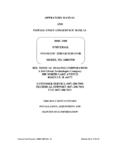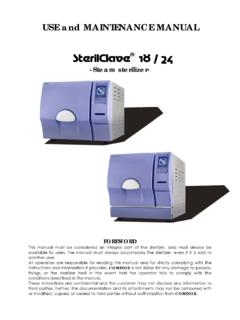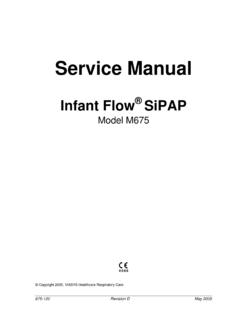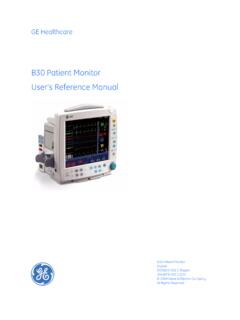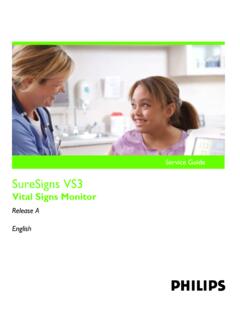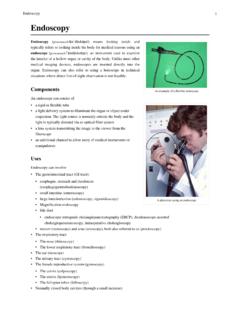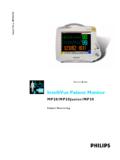Transcription of IntelliVue Patient Monitor - Frank's Hospital …
1 INSTRUCTIONS FOR USE. IntelliVue Patient Monitor MP5. Rele ase G . 0 w i th Softwa r e R e v i s i o n G . 0 x . x x Pa tie n t Monit o ring Part Number M8105-9001C. Printed in Germany 09/08. 4512 610 29031. *M8105-9001C*. M8105-9001C. 1 Table Of Contents 1 Installation 1. Installation Checklist 1. Unpacking and Checking the Shipment 2. Mounting the Monitor 3. Connecting the Monitor to AC Mains 3. Checking Out The Monitor 3. Loading Paper 4. Operating the Monitor 5. Setting the Date and Time 6. Checking Country-Specific Default Settings 6. Handing Over the Monitor 6. 2 Basic Operation 9. Introducing the Monitor 9. Operating and Navigating 13. Operating Modes 19. Understanding Screens 20. Using the XDS Remote Display (not MP5T) 21.
2 Using the Visitor Screen 21. Understanding Profiles 22. Understanding Settings 24. Adjusting a Measurement Wave 25. Freezing Waves 26. Using Labels 27. Entering Measurements Manually 29. Changing Monitor Settings 29. Checking Your Monitor Revision 30. Getting Started 30. Disconnecting from Power 32. Networked Monitoring 32. Using the MP5 with a Host Monitor 33. 3 What's New? 35. What's New in Release 35. What's New in Release 36. 4 Alarms 39. Visual Alarm Indicators 40. Audible Alarm Indicators 41. Acknowledging Alarms 43. Pausing or Switching Off Alarms 44. Alarm Limits 45. Reviewing Alarms 50. i Latching Alarms 52. Testing Alarms 52. Alarm Behavior at On/Off 53. Alarm Recordings 53. 5 Patient Alarms and INOPs 55. Patient Alarm Messages 55.
3 Technical Alarm Messages (INOPs) 61. 6 Managing patients 85. Admitting a Patient 85. Quick Admitting a Patient 87. Editing Patient Information 87. Discharging a Patient 88. Transferring patients 89. Care Groups 92. 7 ECG, Arrhythmia, ST and QT Monitoring 99. Skin Preparation for Electrode Placement 99. Connecting ECG Cables 99. Selecting the Primary and Secondary ECG Leads 100. Checking Paced Status 100. Understanding the ECG Display 100. Monitoring Paced patients 101. Changing the Size of the ECG Wave 103. Changing the Volume of the QRS Tone 103. Changing the ECG Filter Settings 104. Selecting Positions of Va and Vb Chest Leads (for 6-lead placement) 104. Choosing EASI or Standard Lead Placement 105. About ECG Leads 105. ECG Lead Fallback 106.
4 ECG Lead Placements 106. Capture 12-Lead 110. EASI ECG Lead Placement 111. ECG and Arrhythmia Alarm Overview 112. Using ECG Alarms 113. ECG Safety Information 114. About Arrhythmia Monitoring 115. Switching Arrhythmia Analysis On and Off 116. Choosing an ECG Lead for Arrhythmia Monitoring 116. Understanding the Arrhythmia Display 117. Arrhythmia Relearning 120. Arrhythmia Alarms 121. About ST Monitoring 127. Switching ST On and Off 127. Understanding the ST Display 128. ii Updating ST Baseline Snippets 129. Recording ST Segments 130. About the ST Measurement Points 130. ST Alarms 132. Viewing ST Maps 133. About QT/QTc Interval Monitoring 137. QT Alarms 140. Switching QT Monitoring On and Off 141. 8 Monitoring Pulse Rate 143. Entering the Setup Pulse Menu 143.
5 System Pulse Source 143. Switching Pulse On and Off 144. Using Pulse Alarms 144. 9 Monitoring Respiration Rate (Resp) 147. Lead Placement for Monitoring Resp 147. Understanding the Resp Display 148. Changing Resp Detection Modes 148. Changing the Size of the Respiration Wave 149. Changing the Speed of the Respiration Wave 150. Using Resp Alarms 150. Changing the Apnea Alarm Delay 150. Resp Safety Information 150. 10 Monitoring SpO2 153. SpO2 Sensors 153. Applying the Sensor 153. Connecting SpO2 Cables 154. Measuring SpO2 154. SpO2 Signal Quality Indicator (Fast SpO2 only) 155. Assessing a Suspicious SpO2 Reading 155. Changing the Averaging Time 156. Setting the Measurement Mode 156. Understanding SpO2 Alarms 156. Pleth Wave 157.
6 Perfusion Numeric 158. Perfusion Change Indicator 158. Setting SpO2/Pleth as Pulse Source 158. Setting Up Tone Modulation 158. Setting the QRS Volume 159. 11 Monitoring NBP 161. Introducing the Oscillometric NBP Measurement 161. Preparing to Measure NBP 162. Starting and Stopping Measurements 164. iii Enabling Automatic Mode and Setting Repetition Time 165. Enabling Sequence Mode and Setting Up The Sequence 165. Choosing the NBP Alarm Source 166. Switching Pulse from NBP On/Off 166. Assisting Venous Puncture 167. Calibrating NBP 167. 12 Measuring Predictive Temperature 169. Making a Temperature Measurement 169. 13 Monitoring Temperature 173. Making a Temp Measurement 173. Calculating Temp Difference 174. 14 Monitoring Invasive Pressure 175.
7 Setting up the Pressure Measurement 175. Zeroing the Pressure Transducer 176. Adjusting the Calibration Factor 178. Displaying a Mean Pressure Value Only 178. Changing the Pressure Wave Scale 178. Optimizing the Waveform 179. Using the Wave Cursor 179. Non-Physiological Artifact Suppression 179. Choosing the Pressure Alarm Source 179. Calibrating Reusable Transducer CPJ840J6 181. Calculating Cerebral Perfusion 182. Calculating Pulse Pressure Variation 182. 15 Monitoring Carbon Dioxide 185. Using the CO2 Measurement 186. Measuring Microstream CO2 189. Setting up all CO2 Measurements 190. 16 Assigning Two Devices to One Patient 195. How Can You Combine Devices? 195. Functions Available When the Telemetry Data Window is Displayed 199.
8 Functions Available For Devices Connected Via SRR 200. General Telemetry-related Functions 201. Use Models With Telemetry 202. 17 Enhancing Telemetry Monitoring with the Monitor 205. 18 Trends 207. Viewing Trends 207. Setting Up Trends 210. Documenting Trends 213. iv Trends Databases 214. Screen Trends 215. 19 High Resolution Trend Waves 219. OxyCRG 219. Printing Hi-Res Trend Wave Reports 219. Hi-Res Trend Wave Recordings 220. 20 Event Surveillance 221. Event Episodes 221. Events Pop-Up Keys 222. Event Triggers 222. The Events Database 224. Viewing Events 224. Annotating Events 226. Documenting Events 226. 21 ProtocolWatch 231. Severe Sepsis Screening 231. 22 Recording 237. Starting and Stopping Recordings 237. Overview of Recording Types 238.
9 All ECG Waves Recordings 239. Creating and Changing Recordings Templates 239. Changing ECG Wave Gain 240. Recording Priorities 241. Sample Recording Strip 241. Reloading Paper 243. Recorder Status Messages 243. 23 Printing Patient Reports 245. Starting Report Printouts 245. Stopping Reports Printouts 246. Setting Up Reports 246. Setting Up Individual Print Jobs 248. Checking Printer Settings 249. Printing a Test Report 249. Switching Printers On Or Off for Reports 249. Dashed Lines on Reports 249. Unavailable Printer: Re-routing Reports 249. Checking Report Status and Printing Manually 250. Printer Status Messages 251. Sample Report Printouts 252. v 24 Using the Drug Calculator 257. Accessing the Drug Calculator 257. Performing Drug Calculations 258.
10 Charting Infusion Progress 260. Using the Titration Table 260. Documenting Drug Calculations 260. 25 Using the Timer 261. Viewing the Timer 261. Timer Setup Pop-up Keys 261. Setting Up Timers 262. Displaying a Timer On The Main Screen 263. Displaying A Clock On The Main Screen 264. 26 Laboratory Data 265. Viewing Received Data 265. 27 Care and Cleaning 267. General Points 267. Cleaning the Monitor 268. Disinfecting the Monitor 268. Sterilizing the Monitor 268. Cleaning, Sterilizing and Disinfecting Monitoring Accessories 269. Cleaning and Disinfecting the Predictive Temperature Accessories 269. Cleaning Batteries and the Battery Compartment 269. 28 Using Batteries 271. Battery Power Indicators 271. Checking Battery Charge 274.
